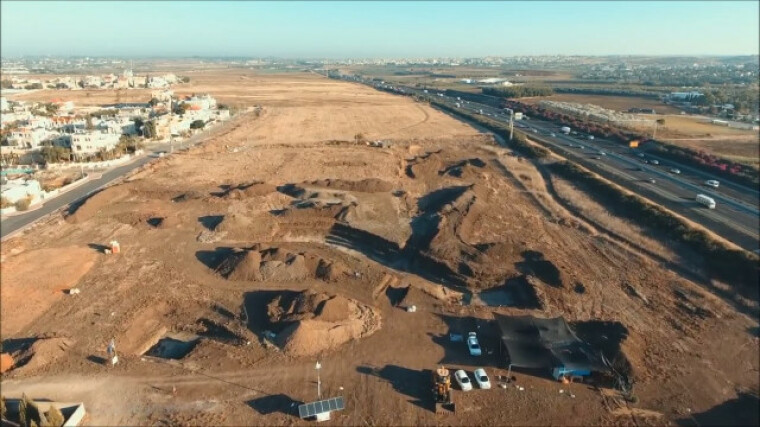Israeli archaeologists unearth hunter-gatherer 'paradise' near busy highway

Israeli archaeologists have discovered a well-preserved site that has been described as a "paradise" used by stone age hunter-gatherers over half a million years ago.
The discovery was made at Jaljulia, northeast of Tel Aviv, next to one of Israel's busiest roads. Archaeologists believe that the site once had a stream, vegetation and an abundance of animals, encouraging hunter-gatherers to return to the area repeatedly.
During the excavations, experts found hundreds of prehistoric tools in an area of ancient riverbed lying only two meters below ground adjoining Route 6. Prof. Ran Barkai, head of archaeology at Tel Aviv University, said that an "extraordinary quantity" of flint heads used as tools of the Acheulian culture have been uncovered at the site.
"It's hard to believe that between Jaljulia and highway 6, five metres below the surface, an ancient landscape some half of a million years old has been so amazingly preserved," Barkai said, as reported by Russia Today.
The researchers believe that the river would have brought flint nodules that were used to make the teardrop-shaped axe-heads, which were said to be the Swiss Army knife during that time. Those tools were then used for a variety of purposes, including butchering the animals that were drawn to the area for its greenery and water.
"So it was like a paradise for the people here. The fact that the site was occupied repeatedly indicates that prehistoric humans possessed a geographic memory of the place, and could have returned here as a part of a seasonal cycle," Barkai said.
Acheulian axe-making culture is associated with homo erectus and early homo sapiens, and is characterized by the distinctive oval and pear-shaped flint hand tools that were used by early humans.
The dating of the hand-axes has been used to trace the early human migration out of Africa into Asia and Europe.
Archaeologists came to the site last year after the area has been designated for new construction. The Israel Antiquities Authority, which conducted the joint excavation with Tel Aviv University, said that the discovery sheds a new light on the period.
Experts believe that the fact that the site had been inhabited repeatedly suggests that early humans had a geographic memory of the place, and could have returned there as part of a seasonal cycle.
"The discovery is incredible because of the state of preservation of the pieces and for their implications in our understanding of this ancient material culture," said Maayan Shemer, excavation director for the authority.
"There is no doubt that researching these finds in-depth will contribute greatly to the understanding of the lifestyle and human behaviour during the period," Shemer added.
 Christians don't have to affirm transgenderism, but they can’t express that view at work: tribunal
Christians don't have to affirm transgenderism, but they can’t express that view at work: tribunal Archaeology discovery: Medieval Christian prayer beads found on Holy Island
Archaeology discovery: Medieval Christian prayer beads found on Holy Island Presbyterian Church in America votes to leave National Association of Evangelicals
Presbyterian Church in America votes to leave National Association of Evangelicals Over 50 killed in 'vile and satanic' attack at Nigerian church on Pentecost Sunday
Over 50 killed in 'vile and satanic' attack at Nigerian church on Pentecost Sunday Ukrainian Orthodox Church severs ties with Moscow over Patriarch Kirill's support for Putin's war
Ukrainian Orthodox Church severs ties with Moscow over Patriarch Kirill's support for Putin's war Islamic State kills 20 Nigerian Christians as revenge for US airstrike
Islamic State kills 20 Nigerian Christians as revenge for US airstrike Man who served 33 years in prison for murder leads inmates to Christ
Man who served 33 years in prison for murder leads inmates to Christ


 Nigerian student beaten to death, body burned over ‘blasphemous’ WhatsApp message
Nigerian student beaten to death, body burned over ‘blasphemous’ WhatsApp message 'A new low': World reacts after Hong Kong arrests 90-year-old Cardinal Joseph Zen
'A new low': World reacts after Hong Kong arrests 90-year-old Cardinal Joseph Zen Iran sentences Christian man to 10 years in prison for hosting house church worship gathering
Iran sentences Christian man to 10 years in prison for hosting house church worship gathering French Guyana: Pastor shot dead, church set on fire after meeting delegation of Evangelicals
French Guyana: Pastor shot dead, church set on fire after meeting delegation of Evangelicals ‘Talking Jesus’ report finds only 6% of UK adults identify as practicing Christians
‘Talking Jesus’ report finds only 6% of UK adults identify as practicing Christians Mission Eurasia ministry center blown up in Ukraine, hundreds of Bibles destroyed: 'God will provide'
Mission Eurasia ministry center blown up in Ukraine, hundreds of Bibles destroyed: 'God will provide' Church holds service for first time after ISIS desecrated it 8 years ago
Church holds service for first time after ISIS desecrated it 8 years ago Burger King apologizes for 'offensive campaign' using Jesus' words at the Last Supper
Burger King apologizes for 'offensive campaign' using Jesus' words at the Last Supper Uganda: Muslims abduct teacher, burn him inside mosque for praying in Christ’s name
Uganda: Muslims abduct teacher, burn him inside mosque for praying in Christ’s name